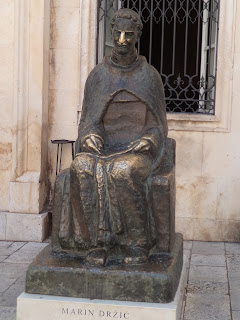A Day in Dubrovnik
Monday June 19th
Today we didn't have to catch a bus - a hazardous business as it's a long walk to the nearest bus stop and there are no pavements and a great deal of very fast traffic. A coach took us down to Dubrovnik and we met our tour guide just outside the Pile Gate.
She was an interesting woman, who lives just outside the city, though she used to live in the city itself. She told us that 10 years ago, there were 5000 people living in the city, but today there were only 800. This is because prices have risen so high that people have sold their houses and moved out. She also told us that the rent for a shop on the main street was €25000 a month, which explains the rip-off prices.
Once again we went inside the Pile Gate through the city walls. I forgot to mention yesterday that the walls were built between the 8th and 16th centuries, and are quite massive. You can walk round them, it's 2 kilometres. We didn't, it was really far too hot today.
Once inside the gate, the guide took us first to the Franciscan Monastery, originally built in 1337 and rebuilt in 1667 after the great earthquake. It's still a monastery today, though there are now only 6 monks, instead of the original 300. The cloisters are still in their original state, though the frescoes have been repainted and restored.
The Old Pharmacy, located inside the Franciscan monastery, was opened in 1317. It is the third oldest pharmacy in Europe.
In the open space just inside the Pile gate and very close to the Franciscan Monastery is a large 16-sided drinking fountain built by Onofrio de la Cava, hence called Onofrio's fountain.
It was built in 1443, but suffered heavily in the 1667 earthquake. You can see that the dome is now brick, but apparently it was originally marble.
After walking down the main street, our next stop was the Sponza Palace, built in a mixed Gothic and Renaissance style between 1516 and 1522
The palace has served a variety of public functions, including as a customs office and bonded warehouse, mint, armoury, treasury, bank and school. It survived the 1667 earthquake without damage. It is now home to the city archives, which hold documents dating back to the 12th century. Paul and I went in later after the tour to look at the room dedicated to the siege of Dubrovnik in 1991 and 1992, when 300 people were killed. The photos of the damage were horrifying, though you can scarcely see it now. Our guide pointed out the holes from shrapnel in various buildings.
Below is the cathedral of Dubrovnik, dedicated to St Blaise, the patron saint of Dubrovnik. It was built in 1715 by a Venetian architect on the foundations of the earlier medieval church which was badly damaged in the great earthquake of 1667. A legend relates that some of the money for the original church was donated by Richard the Lionheart, possibly in gratitude for his surviving a storm at sea.
Before we went in to the cathedral, I noticed this rather nice statue of Marin Držić, a Renaissance playwright and prose writer who lived in the 16th century. He was trained and ordained as a priest, though he later lost interest in this.
Rubbing his nose is supposed to bring you good luck - hence his shiny nose.
We went into the cathedral, which is Baroque in style, so Paul did not like it at all. It was, however, rather simpler than some other Baroque churches we have visited. The main altar has a triptych of the Assumption of the Virgin, said to be by Titian and probably dating from 1552.
Personally, I would doubt the attribution to Titan. Our guide felt it was more likely to be 'school of Titan'.
During the tour, our guide made many suggestions of other places in the city we might visit, and also suggested cafés and restaurants which might not be quite such a rip-off. Paul sat by the harbour in the shade and watched the ships for a bit, strolled through the market, and stopped for a much needed coffee.
We wandered through some of the streets we had not visited before. Dubrovnik differs from other cities in that there are no modern buildings at all, which is a refreshing change. It does suffer from a surfeit of visitors though, so wandering the narrow streets can be frustrating and taking photos is difficult.
This is one of the side streets, narrower than the main street but not as narrow as some of the side streets, which are often so narrow there is only room for 2 people, one in each direction.
I was only able to take this photo because yesterday's cruise ship had left and today's was a little late in arriving. Later, once the people from the latest cruise ship arrived, the side streets became impossible.
As you get some distance from the main streets, you get to the stairs; the streets on both sides of the city rise up towards the walls.
It was extremely hot, so we left the city and the coach took most of us back to the hotel for the remains of the afternoon and evening.









No comments:
Post a Comment